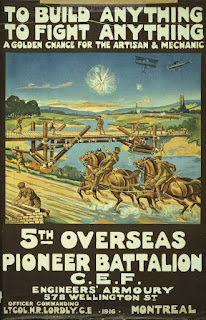 |
| Recruitment poster for CEF Pioneer battalion. |
When British and French forces managed to halt invading German forces in northern France and Belgium late in 1914, two massive armies faced one another along the lengthy, static Western Front. The British Expeditionary Force (BEF) initially relied on French civilian labor to unload and transport equipment and supplies required on the front lines. During the war's early months, infantry soldiers dug trenches, installed barbed wire, and moved munitions and supplies to the front lines, tasks that were appropriately labeled 'fatigue routine'. The inefficiency of these practices quickly became apparent. French labourers were unable to maintain the pace required to move the large quantities of supplies, and utilizing infantry soldiers as construction labor reduced the number of men available to fight.
In addition, as the war progressed, a much greater focus on field engineering emerged as trench construction, defensive reinforcements, enhanced road and railroad transportation became increasingly vital. As a result, in December 1914, British commanders decided to recruit and organize several 'labor' and 'pioneer' units, each with specific tasks. Railway Companies were located at major transportation centres such as Le Havre, France, where they unloaded and moved the large quantities of supplies required to fight the war. Twelve Royal Engineering Labor Battalions carried out railroad construction and transportation. Finally, in December 1914, a Pioneer Battalion was formed in each infantry division and assigned the task of completing construction work as required along and behind the front lines.
 |
| CEF Pioneer Badge. |
In total, Canada provided seven pioneer battalions as part of its wartime contributions. Several units were initially recruited as infantry battalions before being redesigned 'pioneers'. The 48th Infantry Battalion, for example, was organized in Victoria, BC in February 1915, traveled to England in July and was re-designated the 3rd Pioneer Battalion in January 1916. Four other infantry battalions - 67th, 107th, 123rd and 124th - were also transformed into pioneer battalions but retained their infantry numbers.
Pioneer battalions maintained channels of communication and transport, dealt with the movement and handling of munitions, built and repaired various structures and fortifications. In doing so, they provided essentially the same services as CEF engineering units, although they remained under infantry command. This anomaly was corrected in mid-1917, when pioneer units were reorganized and placed under direct control of the Engineers branch of the Canadian Corps. At that time, one unit - 1st Pioneer - was re-designated a Railway Troop. Another unit - the 3rd Pioneer - was disbanded and its members were reassigned to several infantry battalions.
 |
| An Australian Pioneer Battalion constructing a fortification at the front. |
Under Currie's direction, the three engineering companies connected to each Canadian Division were expanded and combined into one Engineer Brigade, under a separate headquarters. The Brigade consisted of three engineering battalions of 1000 men each, along with a Pontoon Bridging and Transport Unit. Additional personnel required to staff the battalions was obtained by disbanding the remaining pioneer units, the 1st and 2nd Tunnelling Companies, and three 5th Division Engineers field companies.
Currie's reorganization plan was completed by the end of July 1918. Much of the success achieved by the Canadian Corps during the last 100 days of the war was attributed to this restructuring. As Canadian units advanced into German-held territory, engineering units possessed sufficient manpower to complete vital tasks, such as bridge building and repair, without requiring assistance from infantry units.
 |
| Ist Canadian Pioneers Badge. |
The pioneers' crucial role in the war was not forgotten. When the Second World War broke out, on October 17, 1939, the British government created the Royal Pioneer Corps, a unit designed to complete 'light engineering tasks'. Today, it is known as the Royal Logistics Corps (1993) and plays an integral role in the implementation of military strategy on the battlefield. Similarly, today's Canadian Armed Forces include several 'combat engineer regiments' designed to carry out such tasks as road clearance, disposal of explosive ordnance, heavy equipment operation and combat support. These modern units continue the excellent tradition of military service established by the 'pioneers' of the past.
*****
Sources:48th Battalion, CEF (3rd Pioneer Battalion). The Great War Forum. Available online.
Broznitsky, Peter. "3rd Pioneer Battalion". Russians in the CEF. Available online.
Payne, Dr. David. "The British Pioneer Battalions and Labour Corps on the Western Front." The Western Front Association. Available online.
Pioneer (military). Wikipedia: The Free Encyclopedia. Available online.
Pioneer Battalions. Oxford Companion to Australian Military History. Available online at Answers.com.
Pioneer Battalions. Canadian Expeditionary Force Study Group. Available online.
WW I Pioneer Battalions. The Great War Forum. Available online.
No comments:
Post a Comment